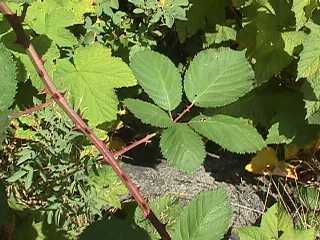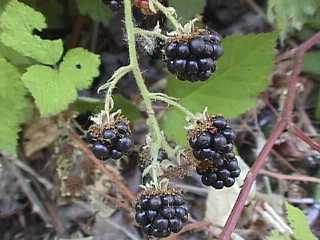

General Species Description
- Young stems are green, while older stems can be deep red to burgundy. Invasive with sprawling armored stems of strong sharp prickles.
Leaves
- Leaves are alternate, 12-25cm wide, green above with white hairs below, and prominate veins. There are 3-5 leaflets, oval, with toothed margins.
Inflorescence/Flowers
- The flowers of this shrub are white to pinkish, and bloom in April through June.
Fruits
- The fruits are blackish-purple when ripe.
Habitat
- Rubus procerus can dominate disturbed upland sites. Prefers bright sun, and is intolerant to deep shade. Grows along roadsides, railroad grades, disturbed pastures, and fence rows.
Range
- Found from British Colombia south to California, mostly west of the Cascades.
Similar Species
- Himalayan blackberry can be confused with Rubus ursinus, yet this species has 3-lobed leaves, and stems are delicate and creeping.
Ecological Value
- Birds and mammals consume the fruits. Excellent escape habitat. Nest sites for songbirds and sparrows. Has been used to stabilize road cuts.
Human Value
- Has been raised for it's fruit to make jams, pies and just for eating plain.
References
- Cooke, Sarah. Field Guide to the Common Wetland Plants of Western Washington and Northwestern Oregon. Seattle Audubon Society, 1997.
This page was created by: Christina Norton, August 2000
Return to Northwest Oregon Wetland Plants Project